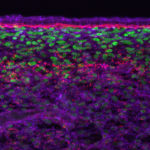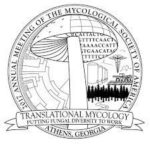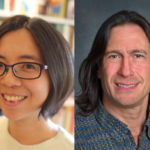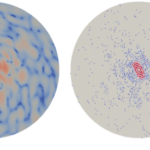Sanjay Kumar, a Berkeley Lab faculty scientist in Biological Systems and Engineering (BSE), and Elena Kassianidou, a graduate student working in his lab, are co-authors on a UC Berkeley-led study published in the journal Science which for the first time linked mechanical forces acting on skin cells in a developing organism to the activation of specific genes that make the cells differentiate into more specialized types, such feathers. The researchers grew skin taken from week-old chicken eggs on artificial substrates generated by Kumar and Kassianidou to mimic the stiffness of tissues that underlie the skin in the bird. The work could pave the way to growing artificial skin for grafts that looks like normal human skin with proper spacing of hair follicles and sweat pores. Read more from the UC Berkeley News Center.
Glass Named Fellow of the Mycological Society of America
N. Louise Glass, director of the Environmental Genomics and Systems Biology Division, is being named a fellow of the Mycological Society of America (MSA) at their annual meeting being held this week in Athens, GA. MSA Fellows recognize mid-career members and also MSA volunteers. Glass is being honored as an outstanding mycologist who has served the MSA in several capacities, including as a member of both the Society’s leadership body and the Editorial Board of Mycologia, the official journal of the MSA. Read more in the MSA meeting announcement.
DOE Renews Funding for Joint BioEnergy Institute at Berkeley Lab
 The Department of Energy’s Joint BioEnergy Institute (JBEI), led by Berkeley Lab, is one of four DOE Bioenergy Research Centers to receive funding in support of innovative research on biofuels and bioproducts. The four centers will receive a total of $40 million. The award marks the next research phase at JBEI, originally established in 2007. Read more in the Berkeley Lab News Center.
The Department of Energy’s Joint BioEnergy Institute (JBEI), led by Berkeley Lab, is one of four DOE Bioenergy Research Centers to receive funding in support of innovative research on biofuels and bioproducts. The four centers will receive a total of $40 million. The award marks the next research phase at JBEI, originally established in 2007. Read more in the Berkeley Lab News Center.
Epigenetic Effects of ‘Genomic Parasites’ Impact Their Evolution
In a study published in eLife, Biological Systems and Engineering (BSE) postdoctoral researcher Grace Lee and senior scientist Gary Karpen investigated the extent to which transposons—bits of DNA that copy themselves and jump to other locations in the genome—harm organisms through epigenetic means, such as changing the way DNA is packaged in cells, and whether this influences how transposons evolve. In a Q&A with the journal, Lee explained the background of the research, the specific question she and Karpen were interested in, and the most illuminating result among their findings.
New Algorithms Extract Biological Structure from Limited Data
A cross-disciplinary effort by Berkeley Lab scientists has yielded a new algorithmic approach for determining 3D molecular structures from single-particle X-ray free-electron laser (XFEL) imaging. Peter Zwart of the Molecular Biophysics & Integrated Bioimaging Division (MBIB) worked with James Sethian and Jeffrey Donatelli of the Computational Research Division’s Mathematics Group to create the multi-tiered iterative phasing (M-TIP) framework, which uses advanced mathematical techniques to extract nano-scale biological structures from sparse and noisy diffraction data. A paper detailing the approach was published in the Proceedings of the National Academy of Sciences.
- « Previous Page
- 1
- …
- 147
- 148
- 149
- 150
- 151
- …
- 213
- Next Page »
Was this page useful?







